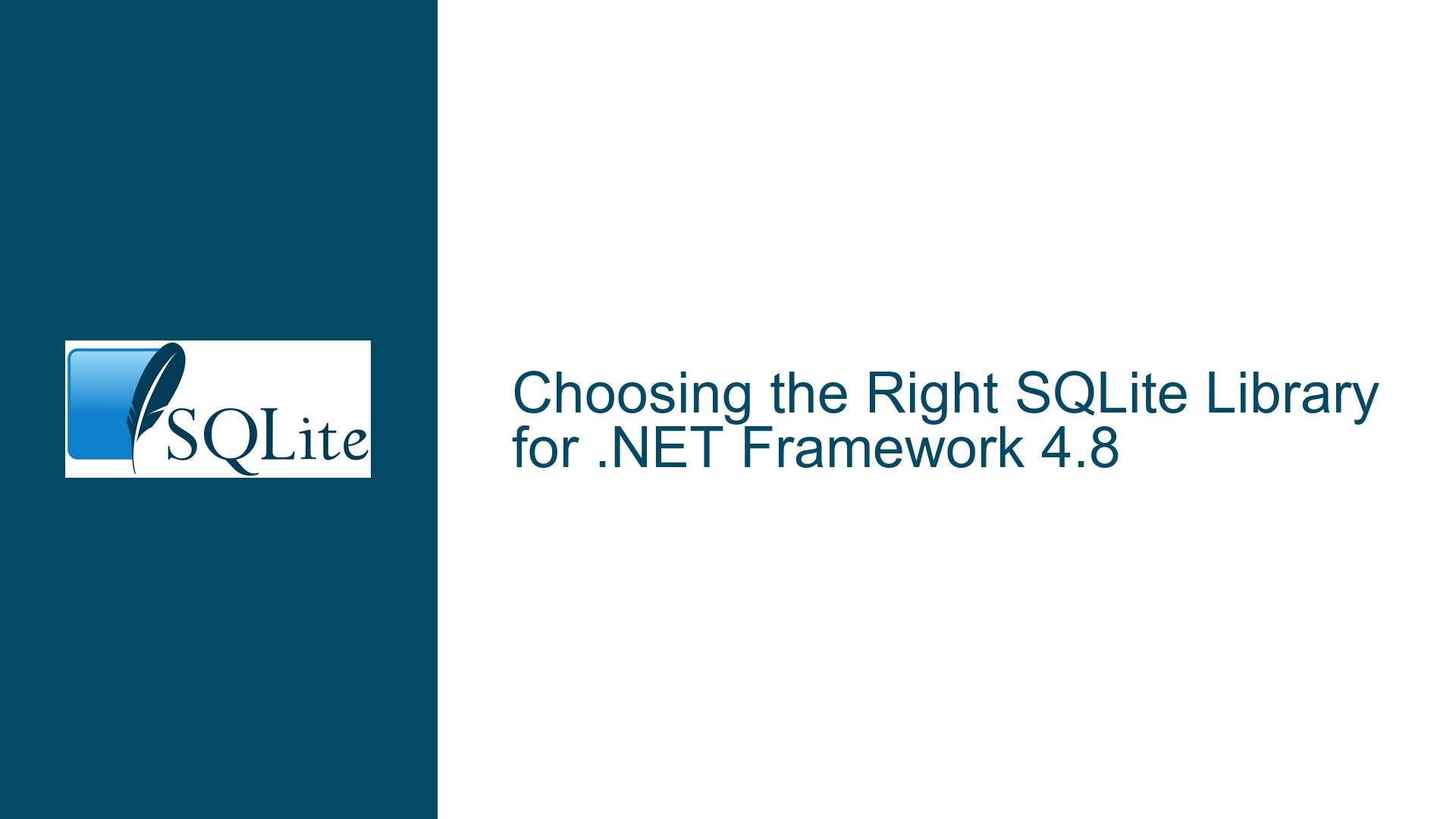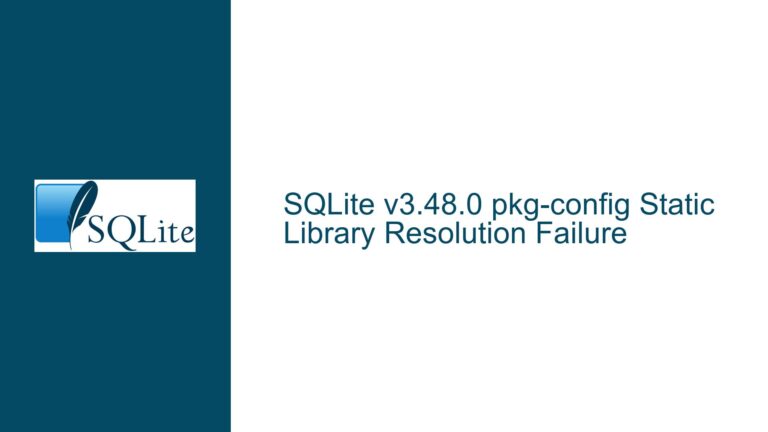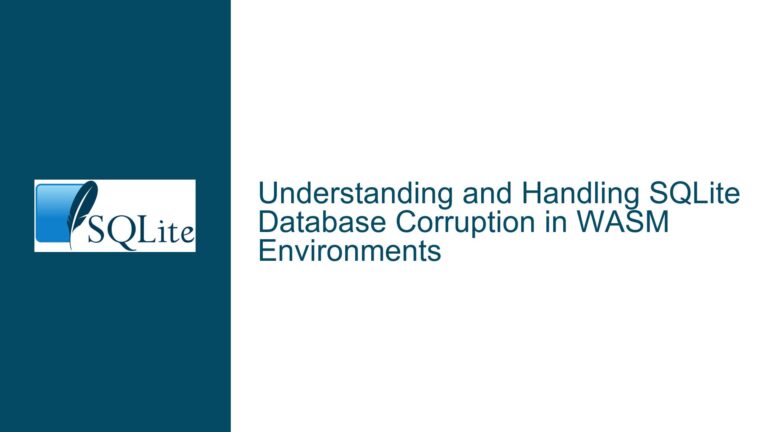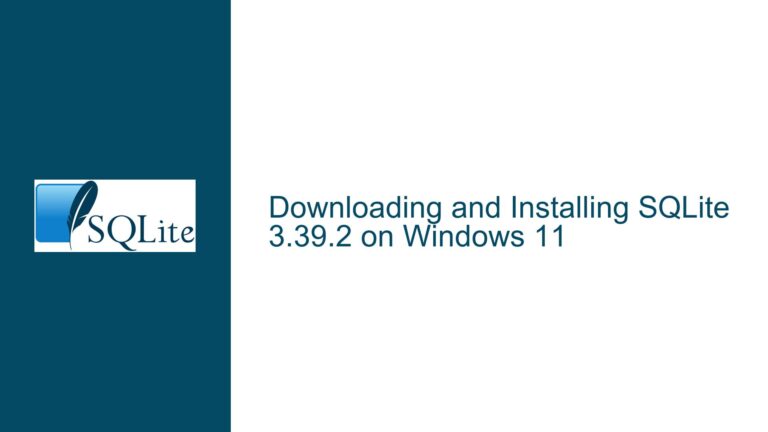Choosing the Right SQLite Library for .NET Framework 4.8
Understanding the Compatibility of SQLite with .NET Framework 4.8
When integrating SQLite into a .NET Framework 4.8 project, the primary challenge lies in selecting the appropriate library that supports ADO.NET-style commands, akin to those used with OleDbConnection and OleDbCommand. The .NET Framework 4.8, being a Windows-specific implementation of the .NET platform, requires libraries that are specifically tailored to its architecture and runtime environment. The confusion often arises from the plethora of available NuGet packages, many of which target .NET Standard or .NET Core, rather than the .NET Framework.
The .NET Standard is a formal specification of .NET APIs that are intended to be available on all .NET implementations. While this promotes cross-platform compatibility, it can sometimes lead to issues when specific functionalities or optimizations available in the .NET Framework are not fully supported. Therefore, when working with .NET Framework 4.8, it is crucial to identify libraries that are explicitly designed for this environment, ensuring that all necessary features and performance optimizations are available.
Identifying the Correct System.Data.SQLite Package
The System.Data.SQLite package is a widely-used library that provides ADO.NET support for SQLite. However, the complexity of its download page and the variety of available versions can be daunting. For .NET Framework 4.8, the correct approach is to download the "Precompiled Binaries for 64-bit Windows (.NET Framework 4.6)" and the corresponding 32-bit version. These binaries include the necessary managed and native interop assemblies required for seamless integration with .NET Framework 4.8.
The managed-only core assembly, System.Data.SQLite.dll, is essential for executing ADO.NET commands. Additionally, the native interop assemblies, SQLite.Interop.dll for both x86 and x64 architectures, are required to handle the low-level interactions with the SQLite database engine. Placing these files in the appropriate directories within your project ensures that the application can locate and utilize them correctly during runtime.
Implementing the System.Data.SQLite Library in Your Project
To integrate the System.Data.SQLite library into a .NET Framework 4.8 project, follow these detailed steps:
Download the Correct Binaries: Navigate to the System.Data.SQLite download page and locate the "Precompiled Binaries for 64-bit Windows (.NET Framework 4.6)" section. Download both the 64-bit and 32-bit versions, ensuring compatibility with your development and deployment environments.
Organize the Files: Create a directory structure within your project to house the downloaded binaries. Place the System.Data.SQLite.dll file in the root directory of your application. Create subdirectories named "x86" and "x64" within the root directory, and place the corresponding SQLite.Interop.dll files in their respective folders.
Add References: In your Visual Studio project, add a reference to the System.Data.SQLite.dll file. This can be done by right-clicking on the "References" node in the Solution Explorer, selecting "Add Reference," and browsing to the location of the System.Data.SQLite.dll file.
Configure the Build: Ensure that your project is configured to build for the correct platform (x86 or x64). This can be set in the project properties under the "Build" tab. Selecting the appropriate platform ensures that the correct SQLite.Interop.dll file is used during runtime.
Write ADO.NET Code: With the library properly integrated, you can now write ADO.NET-style commands to interact with your SQLite database. Use the SQLiteConnection class to establish a connection to the database, and the SQLiteCommand class to execute queries and commands.
Testing and Debugging: After implementing the necessary code, thoroughly test your application to ensure that all database interactions are functioning as expected. Pay close attention to any runtime errors or performance issues, as these may indicate problems with the library integration or platform configuration.
Addressing Common Issues and Misconfigurations
One of the most common issues when integrating SQLite with .NET Framework 4.8 is the misplacement or incorrect referencing of the native interop assemblies. If the SQLite.Interop.dll files are not placed in the correct directories or if the project is not configured to build for the appropriate platform, the application may fail to locate these files at runtime, resulting in errors such as "Unable to load DLL ‘SQLite.Interop.dll’."
To resolve this, double-check the directory structure and ensure that the SQLite.Interop.dll files are placed in the "x86" and "x64" subdirectories within the root directory of your application. Additionally, verify that the project is set to build for the correct platform, matching the architecture of the SQLite.Interop.dll files being used.
Another potential issue is the use of outdated or incompatible versions of the System.Data.SQLite library. Always ensure that you are downloading the latest stable release that is explicitly designed for .NET Framework 4.8. Using an incompatible version may result in missing features or unexpected behavior.
Optimizing Performance and Ensuring Stability
Once the System.Data.SQLite library is correctly integrated and all common issues have been addressed, it is important to focus on optimizing the performance and ensuring the stability of your application. SQLite is known for its lightweight and efficient design, but there are several best practices that can further enhance its performance in a .NET Framework 4.8 environment.
Connection Pooling: Utilize connection pooling to minimize the overhead associated with establishing and closing database connections. SQLiteConnection supports connection pooling out of the box, but it is important to properly manage connection objects to avoid resource leaks.
Parameterized Queries: Always use parameterized queries to prevent SQL injection attacks and improve query performance. Parameterized queries allow the SQLite engine to cache and reuse query plans, reducing the overhead of query compilation.
Transaction Management: Use transactions to group multiple database operations into a single atomic unit. This not only ensures data consistency but also improves performance by reducing the number of disk I/O operations.
Indexing: Properly index your database tables to speed up query execution. Analyze your query patterns and create indexes on the columns that are frequently used in WHERE clauses, JOIN conditions, and ORDER BY clauses.
Vacuuming: Periodically run the VACUUM command to reclaim unused space and optimize the database file. This is especially important in applications with frequent insert, update, and delete operations.
Error Handling: Implement robust error handling to gracefully manage exceptions and ensure that your application remains stable even in the face of unexpected errors. Use try-catch blocks to capture and handle exceptions, and log detailed error information for debugging purposes.
Exploring Alternative Approaches
While the System.Data.SQLite library is a popular choice for integrating SQLite with .NET Framework 4.8, there are alternative approaches that may be worth considering depending on your specific requirements and constraints.
Entity Framework: If your application requires a higher-level abstraction for database interactions, consider using Entity Framework with an SQLite provider. Entity Framework provides an object-relational mapping (ORM) layer that simplifies database operations and reduces the amount of boilerplate code.
Dapper: For applications that require lightweight and fast data access, Dapper is a micro-ORM that can be used with SQLite. Dapper provides a simple and efficient way to map query results to .NET objects, making it a good choice for performance-critical applications.
SQLite-net: SQLite-net is a lightweight and easy-to-use library for working with SQLite in .NET applications. It provides a simple API for database operations and is well-suited for small to medium-sized projects.
Custom Wrappers: In some cases, it may be beneficial to create custom wrappers around the SQLite C API to achieve specific functionality or performance optimizations. This approach requires a deeper understanding of the SQLite internals and is generally reserved for advanced use cases.
Conclusion
Integrating SQLite into a .NET Framework 4.8 project requires careful consideration of the appropriate library and proper configuration to ensure compatibility and optimal performance. The System.Data.SQLite library is a robust and widely-used solution that provides ADO.NET support for SQLite, making it an excellent choice for most applications. By following the detailed steps outlined in this guide, you can successfully integrate SQLite into your .NET Framework 4.8 project and leverage its powerful features to build efficient and reliable database-driven applications.
Remember to pay close attention to the directory structure, platform configuration, and error handling to avoid common pitfalls and ensure a smooth development experience. Additionally, consider exploring alternative approaches such as Entity Framework, Dapper, or SQLite-net if they better align with your project requirements. With the right tools and best practices, you can harness the full potential of SQLite in your .NET Framework 4.8 applications.






